Reverse the "Sitting Disease": 11 Essential Stretches You Can Do Right Now
We spend a lot of hours sitting, often without thinking about how our bodies respond. Sitting for long stretches shortens some muscles and weakens others, which can lead to stiffness, pain, and low energy. These effects are commonly called "sitting disease," a simple way to describe the wear that prolonged inactivity can place on circulation, joints, and posture. The good news is that short, targeted stretches can interrupt that pattern and help restore mobility, ease tension, and improve how you feel during the day. This post offers eleven gentle, practical stretches you can do right where you are—at your desk, beside your chair, or on a quick walk break. Each stretch includes clear steps, breathing cues, and an easy modification so you can match the move to your current ability. Start with just one or two stretches and build up; consistency matters more than intensity. If you have ongoing pain, a recent injury, or a diagnosed condition, check with a healthcare provider before trying new movements. Otherwise, these moves are designed to be approachable and effective for most people who sit a lot. Try the sequence now, notice how your body responds, and use it as a simple daily reset that supports better posture and greater comfort over time.
1. Neck release: gentle cervical mobility
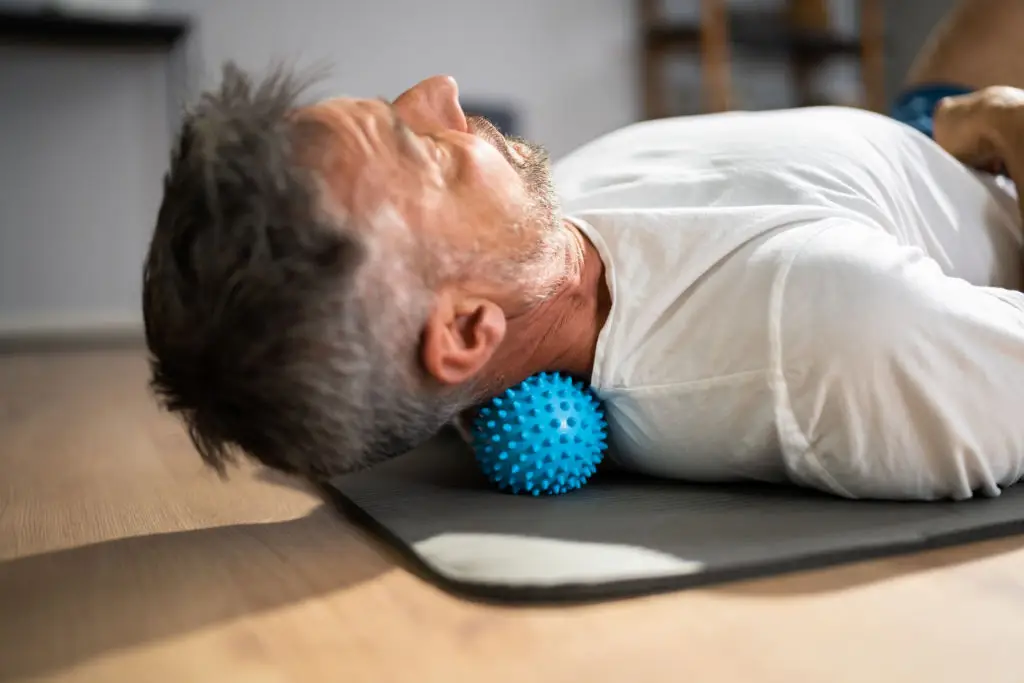
Why your neck feels tight: long hours looking down at screens or forward toward documents leads to muscle strain in the back of the neck and tension in the upper shoulders. Start seated with your feet flat and your spine tall. Breathe in slowly, then as you exhale, drop your right ear toward your right shoulder and use your right hand to apply very light pressure just above the collarbone. Hold for 30 seconds while taking steady breaths, then slowly roll your chin down toward your chest and gently lift your head to center. Repeat the first side and then perform the same steps on the left. For a small progression, rotate the chin slightly upward toward the ceiling before returning to center to add a little extension—only if that feels comfortable. If your range is limited, shorten the hold to 10–15 seconds and repeat more often. Stop immediately with sharp pain, sudden dizziness, or new numbness; those are signs to consult a clinician. This neck release helps relieve stiffness, improves head mobility, and cues better alignment for the rest of your spine.
2. Upper-trap shoulder roll and release
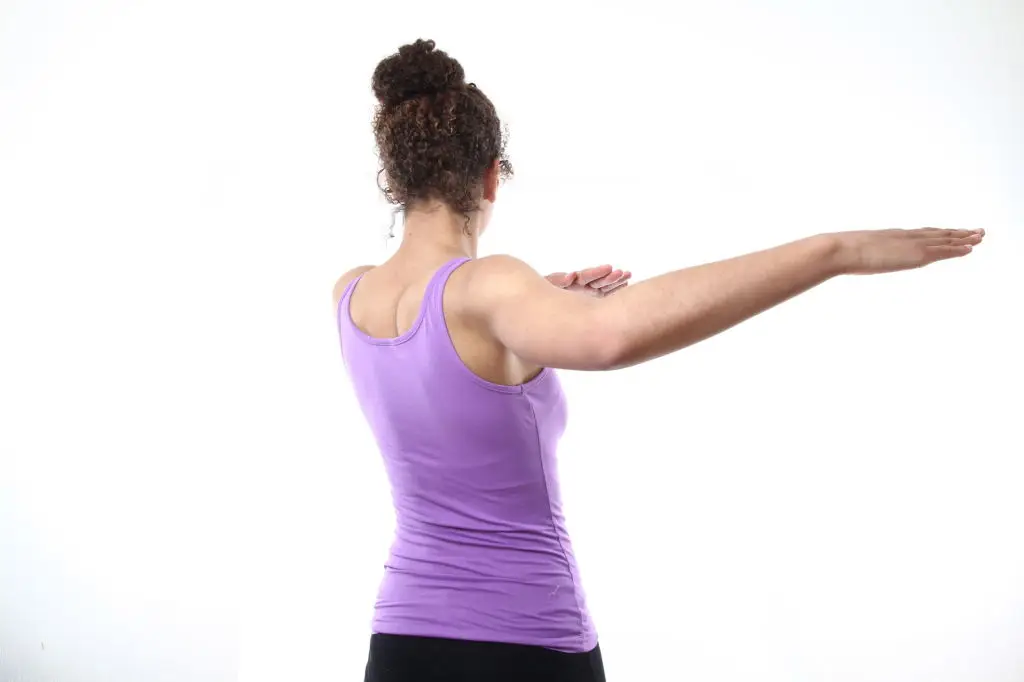
Rounded shoulders and a tight upper trapezius are common after long desk sessions. Begin seated with your spine neutral and both feet on the floor. Inhale as you draw your shoulders up toward the ears, pause briefly, and then exhale while rolling them back and down in a smooth motion. Repeat this five to eight times to mobilize the shoulder girdle and encourage scapular motion. Next, find a tennis ball or a small massage ball and place it between your upper-trap and a wall, then lean into the ball gently and roll across tender spots for 20–30 seconds each side. If a ball feels too intense, use your thumb and fingers to knead the area with light pressure while breathing slowly. These techniques release trigger points and reduce shoulder tension, helping you lift the chest without strain. If you have shoulder instability, keep the movements small and avoid heavy pressure; consult a physical therapist for hands-on guidance and tailored progressions.
3. Chest opener at the doorway

Sitting with rounded shoulders shortens the pectoral muscles and locks the front of the torso into a collapsed position. Stand in a doorway and place your forearms on the frame with elbows roughly shoulder height. Step one foot forward and gently lean through the doorway until you feel a comfortable stretch across the front of your chest and shoulders. Keep the neck long and breathe steadily, allowing the ribs to expand with each inhale for added relief. Hold for 20 to 40 seconds, then release and repeat two to three times. If a doorway isn’t available, hug a foam roller or a rolled towel behind your back while standing to open the chest with more support. People with shoulder pain should move slowly and avoid pushing into sharp sensations. This stretch counteracts forward rounding, helps the shoulder blades draw back, and improves breathing mechanics by creating space for fuller inhales.
4. Thoracic rotation for spine mobility
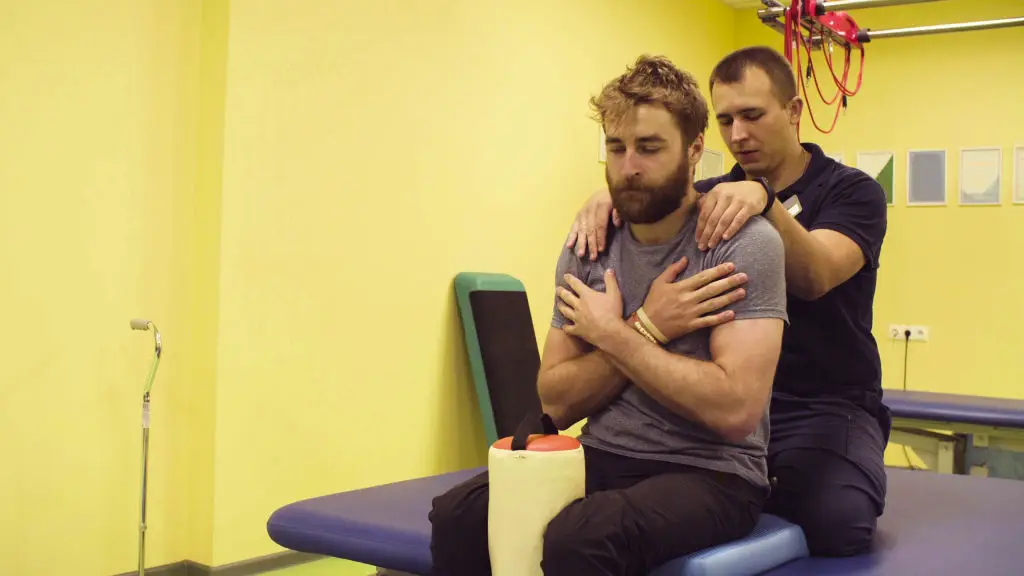
The mid-back, or thoracic spine, often gets stiff from prolonged sitting, which can limit rotation and affect posture. Sit tall in a chair with your feet flat and knees hip-width apart. Cross your arms over your chest or place your hands behind your head, inhale to lengthen, and on the exhale rotate your torso to the right as far as is comfortable without twisting the lower back. Hold the end position for a breath, then return to center and repeat to the left. Aim for 8–10 controlled rotations per side. For more mobility, perform this lying on your back with knees bent and let both knees fall together to one side while keeping your shoulders grounded; that variation gives a gentle, supported twist. Keep movements smooth and avoid forcing rotation through pain. Restoring thoracic mobility helps your shoulders, neck, and breathing work more freely and reduces compensatory strain in the lower back.
5. Hip flexor kneeling stretch
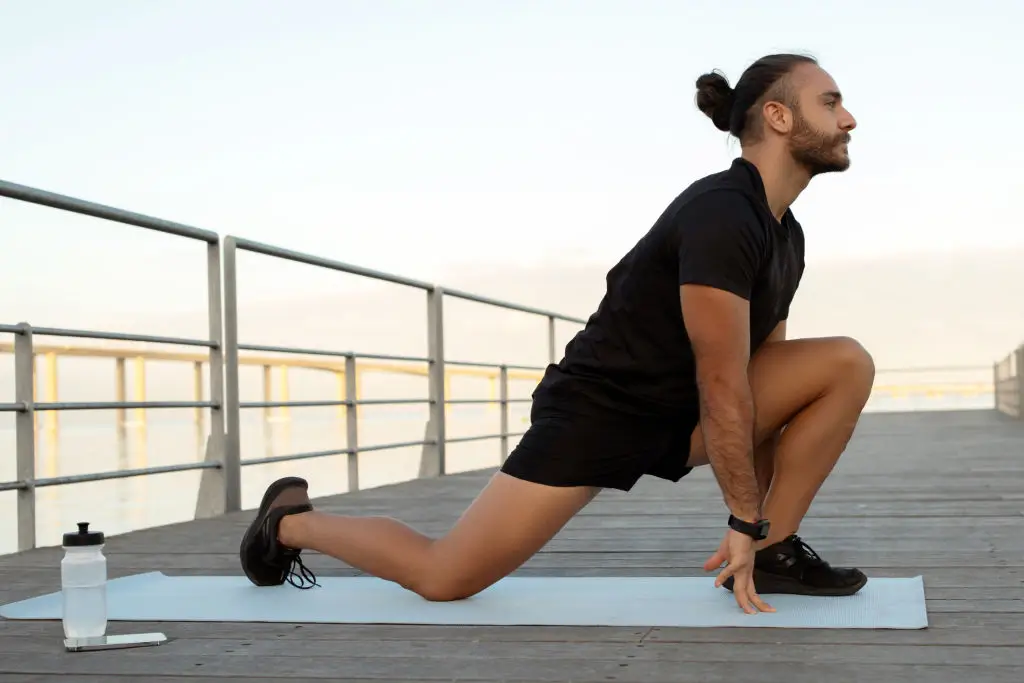
Sitting for hours shortens hip flexors and can tilt the pelvis forward, leading to low-back strain and weak glute activation. Kneel on your right knee with your left foot planted in front, forming a 90-degree angle at both knees. Tuck the tailbone gently by engaging your lower belly, then shift your weight forward until you feel a comfortable stretch through the front of the right hip. Keep the torso upright and breathe steadily for 30 to 40 seconds, then switch sides. If kneeling is uncomfortable, perform the same lunge standing with the back knee supported on a cushion or the edge of a couch. To add a mild progression, lift the arm on the same side as the back leg overhead and lean slightly toward the front leg for a more diagonal stretch. This move helps lengthen the hip flexors, promotes better pelvic alignment, and creates space for stronger hip extension during walking and standing.
6. Hamstring long-sit reach

Tight hamstrings are common when hip flexors shorten and the pelvis rotates; that imbalance can increase lower-back tension. Sit at the edge of a chair or on the floor with one leg extended and the other bent with the foot near the inner thigh. Keep a neutral spine and hinge from the hips as you reach toward the toes of the extended leg, aiming to feel a stretch along the back of the thigh rather than rounding the lower back. Hold 20 to 30 seconds and then switch sides. Use a towel or strap around the foot to support the reach if your hands don’t reach the toes. For a safer progression, keep the knee slightly bent to reduce strain on the back or hamstring origin. Regularly addressing hamstring length supports better pelvic mechanics and can ease stiffness when rising from prolonged sitting.
7. Glute activation and figure-4 release
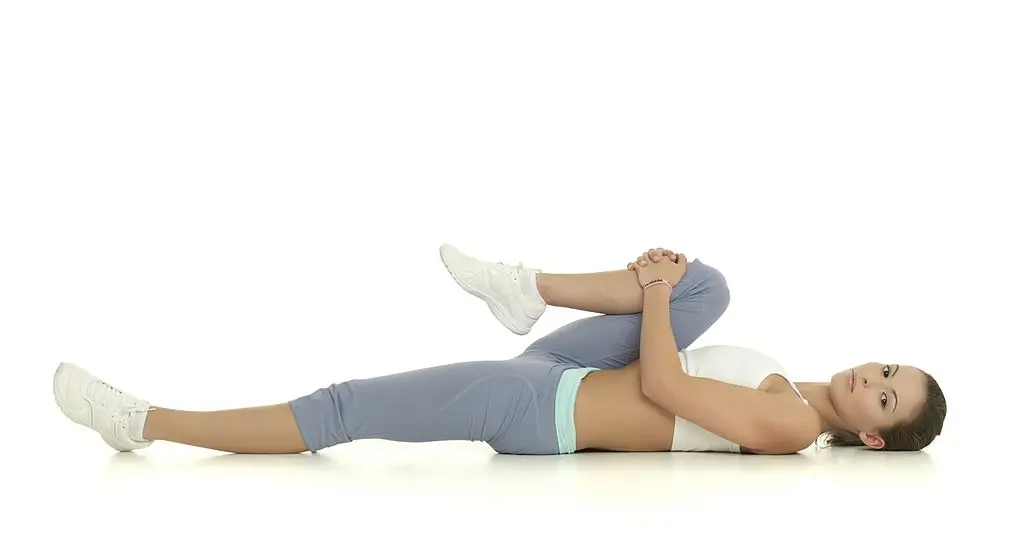
Glutes can become underused when we sit too much, which weakens hip stability and shifts workload to the lower back. Start with a simple activation: sit tall and press one foot into the floor while lifting the opposite knee slightly off the seat for five slow pulses, repeating ten times per side. Follow with a figure-4 stretch by crossing the ankle of the right leg over the left thigh near the knee while seated. Sit tall and hinge forward from the hips with a flat back until you sense a stretch in the right glute, holding for 20–30 seconds before switching sides. If needed, perform the figure-4 lying on your back, bringing the crossed ankle closer to the chest for a supported release. These moves help restore glute engagement and reduce compensatory tension in the lower back, improving standing posture and gait mechanics over time.
8. Lower-back gentle decompression

Prolonged sitting can compress the lumbar spine and make simple movements feel stiff. A gentle decompression can reset the lower back without force. From a hands-and-knees position, sit your hips back toward your heels and extend your arms forward until you feel a comfortable lengthening along the spine—this is child's pose. Breathe deeply for 30 to 60 seconds, allowing each exhale to soften into the stretch. If kneeling is hard, perform a seated forward fold with feet on the floor and hands on the thighs, hinging from the hips and maintaining a long spine. Avoid deep forward flexion if you have a herniated disc or sharp radiating pain; seek professional input in that case. Gentle decompression reduces tension, encourages circulation in spinal tissues, and supports ease when transitioning between sitting and standing.
9. Calf and ankle mobility at the desk
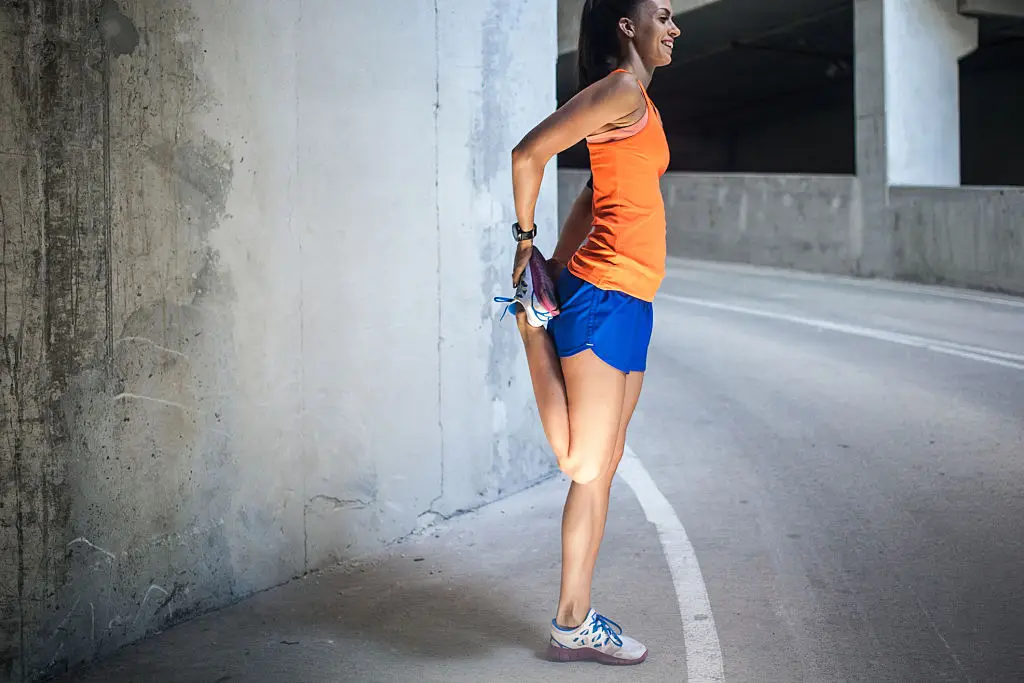
Feet and lower-leg mobility are often overlooked yet crucial for balance and circulation. While seated, practice ankle pumps by flexing the toes up toward the shin and then pointing them away, repeating 15–20 times to encourage blood flow. Stand facing a wall with both hands on it and place one foot back, keeping the heel down to feel a stretch in the calf; hold 20–30 seconds, then switch sides. For a deeper soleus stretch, bend the back knee slightly while keeping the heel down. You can also perform toe raises and single-leg heel raises to build ankle strength and ankle dorsiflexion. These brief practices improve walking mechanics, reduce fatigue from long standing or sitting, and help prevent stiffness when you get up after a long work session.
10. Wrist and forearm relief for typing hands
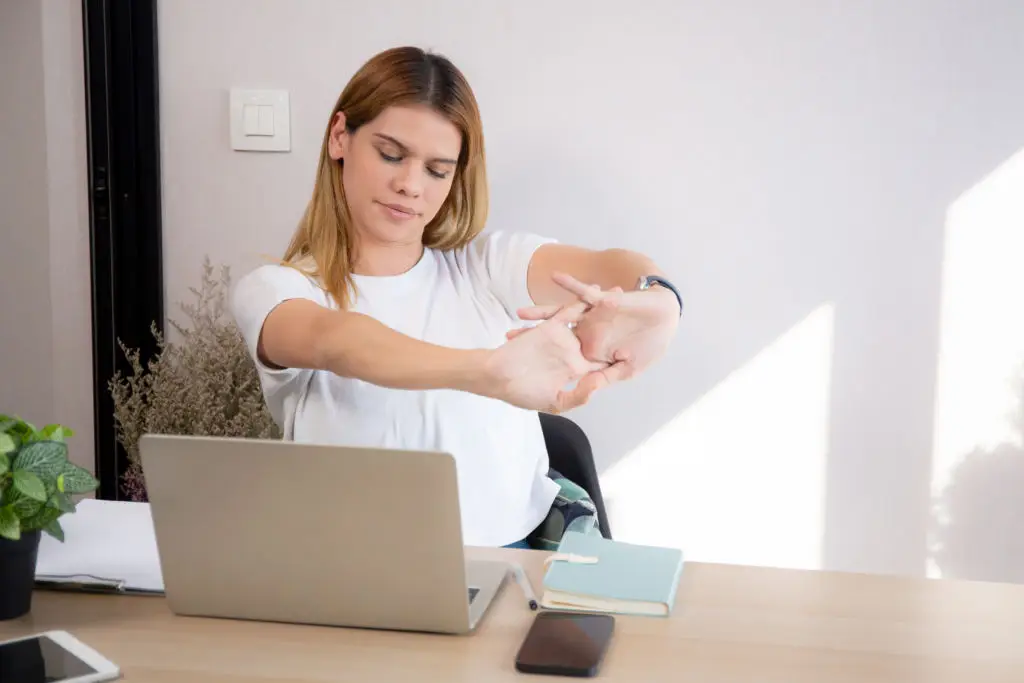
Repetitive typing and mouse use can create tightness in the forearms and wrists, sometimes leading to discomfort or tendon irritation. Start by extending one arm in front with the palm facing down, then use the opposite hand to gently pull the fingers toward you to stretch the forearm extensors; hold 15–20 seconds. Next, flip the palm up and gently pull fingers down to stretch the wrist flexors for the same time. Add tendon glides by making a straight hand, then a hook fist, then a full fist, and finally a straight fist—move through each position smoothly five to eight times. At the desk, take micro-breaks every 20–30 minutes to shake out the hands and re-center the wrists. If numbness or sharp pain appears, stop and seek medical evaluation; persistent symptoms could require a clinician-guided plan.
11. Full-body standing flow (integrative movement)

A short, flowing sequence ties all the individual stretches together and acts as a reset when you return to work. Stand with feet hip-width apart and inhale as you sweep your arms overhead, then exhale as you hinge forward from the hips into a half or full forward fold with a soft knee bend. Inhale to a flat back with hands on shins, then exhale to step back into a gentle lunge with the opposite leg and pause to feel hip lengthening. Move through a slow plank-to-downward-dog if comfortable, then walk hands back to your feet and rise with a breath to standing. This 60–90 second routine improves circulation, engages core and glute muscles, and restores natural spinal motion before you sit again. Scale intensity by shortening the sequence, focusing on breath, or adding longer holds where you feel tight. Make this flow a quick habit at the top of each hour to interrupt sedentary patterns.
Final thoughts: make movement a simple habit

Sitting itself isn’t the enemy; staying in one position for hours without breaks is what creates stiffness, low energy, and discomfort. The eleven stretches above are designed to be practical, approachable, and effective for most people who spend long stretches seated. Start small: pick two stretches you can do today and add them into a routine, perhaps after your morning coffee or midday meeting. Short, frequent movement beats a single long session once in a while—micro-breaks shift circulation, reduce muscle tension, and keep joints moving. Celebrate small wins, and adapt each stretch to fit your comfort level, using props, wall support, or chair variations when needed. If you have ongoing pain or a medical condition, consult a clinician before progressing; a physical therapist can personalize these moves safely. Over weeks, consistent attention to mobility often reduces stiffness and improves posture and breathing. Remember that these gestures are a form of self-care: simple, steady, and compassionate steps that help your body feel better while you live your busy life.